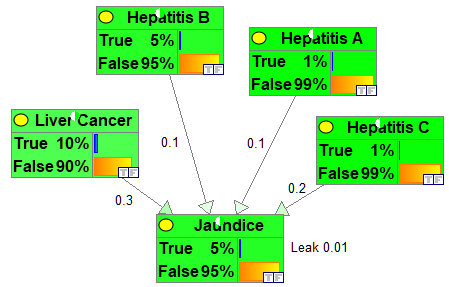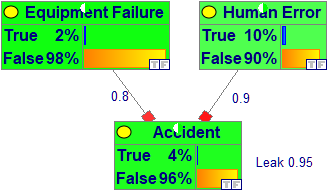The DeMorgan model of interactions between a variable and its parents is flexible and allows for modeling a wide variety of possible interaction patterns. In this section, we show two simple, popular interaction patterns: Noisy-OR and Noisy-AND, familiar to those modelers who have worked with canonical models in the context of Bayesian networks.
The Noisy-OR interaction takes place when all links from parents to the child node are Causes. Consider the following example:

The values of prior probabilities are shown in the parents' prior marginal distributions, the value of strengths of influences are marked on the arcs, the value of Leak in the node Jaundice is 0.01. The model reproduces precisely the NoisyOR.xdsl model in BayesFusion's interactive model repository.
The Noisy-AND interaction takes place when all links from parents to the child node are Requirements. Consider the following example:

The values of prior probabilities are shown in the parents' prior marginal distributions, the value of strengths of influences are marked on the arcs, the value of Leak in the node Accident is 0.95. The model reproduces precisely the NoisyAND.xdsl model in BayesFusion's interactive model repository.
Introduction of Barriers in Noisy-OR models is straightforward: The resulting model will be still a Noisy-OR but the parents' (Barriers') states can be viewed as reversed. The same happens when we introduce Inhibitors in the Noisy-AND model: The resulting model will be still a Noisy-AND but the parents' (Inhibitors') states can be viewed as reversed. Mixing all four types of causal influences in one model makes the model no longer a pure Noisy-OR or a Noisy-AND but a formally correct combination of noisy OR and AND functions that allows for modeling a complex interaction of parents.